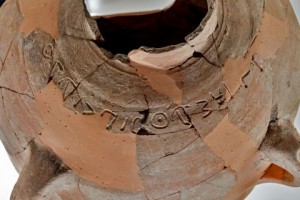
We may never know who Eshba’al Ben Bada was but his name, recently discovered on a 3,000-year-old piece of pottery, provides us with a link to the distant past. The pottery, painstakingly rebuilt after being discovered in Khirbet Qeiyafain in the Valley of Elah in 2012, contains Eshba’al’s name in an ancient Canaanite script. Scholars believe he was a landowner.
Perhaps the most fascinating element of the discovery revealed this week, other than the sheer age of the artifact, is the correlation the name has with Biblical tradition. As Professor Yosef Garfinkel of the Institute of Archaeology of the Hebrew University and Saar Ganor of the Israel Antiquities Authority explains:
“Eshbaʽal (or Ish-boshet) Ben Shaul, who ruled over Israel at the same time as David, is known from the Bible. Eshbaʽal was murdered by assassins and decapitated and his head was brought to David in Hebron (II Samuel, Chaps. 3-4),” he said. “It is interesting to note that the name Eshbaʽal appears in the Bible, and now also in the archaeological record, only during the reign of King David, in the first half of the tenth century BCE. This name was not used later in the First Temple period.The correlation between the biblical tradition and the archaeological finds indicates this was a common name only during that period. The name Bedaʽ is unique and does not occur in ancient inscriptions or in the biblical tradition.”
You can read the full story at the Israeli Antiquities Authorities Blog (which also includes a history of the name itself) or the more reader-friendly version of the same story at Foxnews.com. Previous excavations in the site revealed a fortified city, two gates, a palace and storeroom, all believed to have been dated from the time of David in the late 11th and 10th century.
The words of this author reflect his/her own opinions and do not necessarily represent the official position of the Orthodox Union.